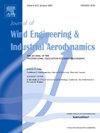Artificial neural networks for predicting mean wind profiles over heterogeneous terrains
IF 4.2
2区 工程技术
Q1 ENGINEERING, CIVIL
Journal of Wind Engineering and Industrial Aerodynamics
Pub Date : 2025-02-01
DOI:10.1016/j.jweia.2024.105969
引用次数: 0
Abstract
This paper presents the application of artificial neural networks (ANNs) for predicting mean wind profile characteristics over heterogeneous terrains. The ANN models integrate salient terrain features to predict the vertical wind profile structure of neutrally stable atmospheric boundary layer (ABL) flows. The research leveraged wind profile data collected in a large boundary layer wind tunnel equipped with a mechanized roughness element grid, which enabled the simulation of a wide range of heterogeneous terrain conditions. Three ANN architectures are examined to determine the most critical terrain features that influence wind profile prediction. Specifically, several input parameters are investigated to capture proximate and distal roughness changes upstream to the measurement location. The results demonstrate the efficacy of the proposed ANN-based approach in accurately predicting mean wind profiles over heterogeneous terrains. While the ANN models exhibit a higher degree of accuracy and reliability, they require large volumes of data that may not be easily accessible. However, the research findings will help advance predictive modeling in wind engineering and deepen our understanding of boundary layer physics by identifying key parameters and developing strategies to accurately capture wind profiles over complex heterogeneous terrains.
预测异质地形平均风廓线的人工神经网络
本文介绍了人工神经网络(ann)在非均质地形平均风廓线特征预测中的应用。人工神经网络模型结合显著地形特征预测大气边界层垂直风廓线结构。该研究利用了大型边界层风洞的风廓线数据,该风洞配备了机械化粗糙度单元网格,可以模拟各种异质地形条件。研究了三种人工神经网络架构,以确定影响风廓线预测的最关键地形特征。具体来说,研究了几个输入参数,以捕获测量位置上游的近处和远处粗糙度变化。结果表明,基于人工神经网络的方法能够准确预测非均匀地形上的平均风廓线。虽然人工神经网络模型表现出更高的准确性和可靠性,但它们需要大量的数据,这些数据可能不容易获得。然而,研究结果将有助于推进风工程的预测建模,并通过确定关键参数和制定策略来准确捕获复杂异质地形上的风廓线,加深我们对边界层物理的理解。
本文章由计算机程序翻译,如有差异,请以英文原文为准。
求助全文
约1分钟内获得全文
求助全文
来源期刊
CiteScore
8.90
自引率
22.90%
发文量
306
审稿时长
4.4 months
期刊介绍:
The objective of the journal is to provide a means for the publication and interchange of information, on an international basis, on all those aspects of wind engineering that are included in the activities of the International Association for Wind Engineering http://www.iawe.org/. These are: social and economic impact of wind effects; wind characteristics and structure, local wind environments, wind loads and structural response, diffusion, pollutant dispersion and matter transport, wind effects on building heat loss and ventilation, wind effects on transport systems, aerodynamic aspects of wind energy generation, and codification of wind effects.
Papers on these subjects describing full-scale measurements, wind-tunnel simulation studies, computational or theoretical methods are published, as well as papers dealing with the development of techniques and apparatus for wind engineering experiments.

 求助内容:
求助内容: 应助结果提醒方式:
应助结果提醒方式:


